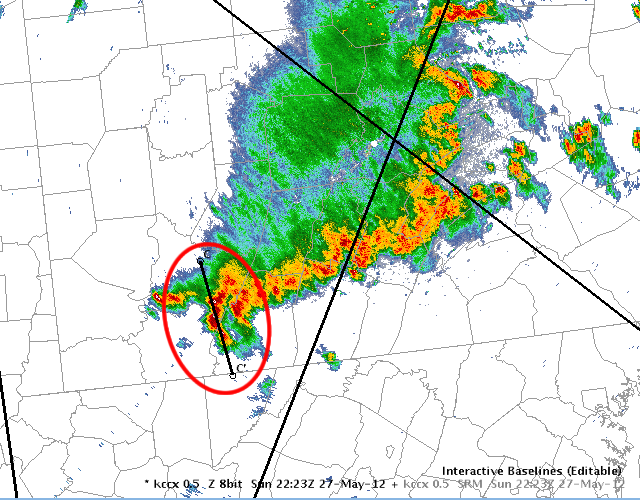Load a Vertical Reflectivity Cross-Section Image Product Using the Volume Browser - OCLO
- 01- CAVE Fundamentals
- Setting the Time Match Basis of a Product
- Loading and Toggling Radar Graphic Overlay Products
- Overlaying CAPE on a Base Reflectivity Product
- Overlaying a Surface Plot on a Base Reflectivity Product
- Overlaying Model Image on Radar and Satellite
- Transferring Screen Products Between the Main Display Pane and Side Panes
- Loading, Arranging, Renaming, and Unloading Additional Map Editors
- Zooming In or Out of a Product View
- Panning a Zoomed-In Image in the Main Display Panel
- Switching the Color Table for a Radar Image Product
- Editing the Current Color Table
- Unload a Map Overlay
- Loading a Map Overlay
- Changing a Map's Display Characteristics
- Loading the Alphanumeric Information for a VWP Product
- Using the AFOS Browser to Load an Area Forecast Discussion
- Move and Adjust Width of AlertViz
- Launch Text Section Log and Display Detailed View
- Loading and Using the AWIPS Data Monitor
- Blinking a Range of Data Values
- Printing the Contents of the Main Display Panel
- Creating a Screen Capture of the Main Display Panel
- Saving/Loading Editor and Perspective Displays
- 02- D2D Fundamentals
- Create a New Procedure
- Opening an Existing Procedure
- Load a Product from the Product Inventory
- Clearing a Product from the Main Display Panel
- Manually Toggling and Looping Single Elevation Angle Products in Time
- Create an Image Combination and Toggle Between the Images
- Use Panel Combo Rotate and All Panel Sample on Dual Pol
- 03- D2D Radar
- Load Radar Products for Single Radar and Radar/MRMS Mosaics
- Toggling Product Displays
- Viewing Radar Cursor Readout Information
- Loading Products into Four-Panel Displays
- Submit an OTR for a Three Hour Precip (THP) Product
- Build a New Request in the RMR GUI
- Managing Active Requests in the RMR GUI
- Loading an All Tilts Product into the Main Display Panel
- Load a VWP Hodograph
- Load a Vertical Reflectivity Cross-Section Image Product Using the Volume Browser
- Load a Horizontal Reflectivity Cross-Section Image Product Using the Volume Browser
- 04- D2D Satellite
- 05- D2D Upper Air
- Load NSHARP into your CAVE Display
- Change NSHARP Configurations
- Cycling Through the Tables
- Toggling Display Insets
- Toggling Graphs and Statistics
- Interact with the Inventory in the D2D Skewt Standard Screen Configuration and Use Keyboard Shortcuts
- Configuring a Sounding and Hodograph Display
- Changing the Parcel Lifting Method
- Display Multiple Active Soundings
- 06- D2D Tools
- 07- D2D Applications
- Issue A New Severe Thunderstorm Warning
- Follow Up a Severe Thunderstorm Warning with a Severe Weather Statement
- Loading an FFMP Basin Trend Graph and Downstream Basin Trace
- Assessing QPE, Ratio, and Diff
- Closing the FFMP Table
- Loading the FFMP Basin Table
- Loading a SCAN Storm Cells Table
- Interacting with the SCAN Storm Cells Table
- Launching the MESO and TVS Tables
- Closing the SCAN Cell Table
Purpose:
This task demonstrates how to use the AWIPS-2 Volume Browser to generate a reflectivity cross-section.Tasks:
- From the Tools menu, select Home.
- Middle-click the Home Location legend text to make the Home Location editable.
- Right-click the radar location on the map to snap the Home Location to the radar location.
- From one of your dedicated radar menus, select 0.5 Z+SRM8.
- Press the “.” key on the keypad to toggle to reflectivity.
- From the Tools menu, select Baselines.

- In the main display panel, select one of the baselines that appears and position it where you want an RCS product to be generated (resize as necessary).
- Note which baseline, identified by letters A-J, you positioned for your RCS product.
- From the Volume menu, select Browser.
- In the Volume Browser window, left-click on the pull-down menu to the right of the Tools menu (by default says “Plan View”) and select Cross Section. When filling out the Volume Browser menus it is not uncommon to have the menus become not selectable (greyed out). If that happens, then you can clear out the fields using the options in the Edit menu, and that will usually fix it.
- In the Sources panel: from the Volume menu select the desired radar.
- Prior to 21.4.1 builds, the Radar menu is a generic menu, and it requires the Home to be placed on the desired radar (see step 1).
- Starting in 21.4.1, the individual local radars are identified in the radar menu, and the Home is not used in the Volume Browser radar loading.
- In the Fields panel: from the Other menu select Reflectivity.
- In the Planes panel: from the Specified menu select the baseline that you positioned previously.

- Left-click on the Load button at the bottom of the Volume Browser window.
- It may take a few seconds to load. Note the cross section has loaded in a new tab.
- For the local 17.3.4 WES-2 Bridge builds, an image will come up when loading.
- For operational AWIPS builds, the Volume Browser loads a contour product, you need to right click on the text legend for the contour product and load as image to obtain a radar image.
- Task Complete!



